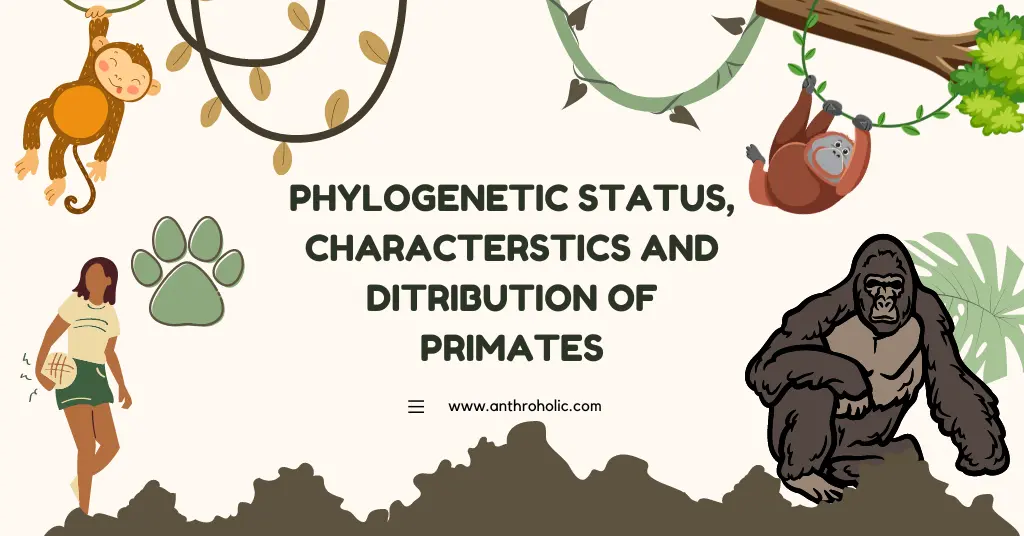AI Answer Evaluation Platform Live Now. Try Free Answer Evaluation Now
Phylogenetic Status Characterstics and Ditribution of Primates
Primates, constituting an essential group of mammals, have piqued scientific curiosity due to their remarkable diversity, unique characteristics, and, particularly, their close genetic ties to humans. This article aims to elucidate the phylogenetic status, key features, and global distribution of primates.

Phylogenetic Status of Primates
Primates are an order of mammals that includes humans, apes, monkeys, and prosimians (lemurs, lorises, and tarsiers) [1]. They form part of the group known as placental mammals, under the superclass Euarchontoglires, which also contains rodents and rabbits [2].
Classification of Primates
Primates are generally classified into two suborders based on their morphological characteristics: Strepsirrhini and Haplorhini.
Table 1: Suborders of Primates
| Suborder | Primates Included |
|---|---|
| Strepsirrhini | Lemurs, Lorises, Galagos |
| Haplorhini | Tarsiers, Monkeys, Apes, Humans |
Strepsirrhini includes lemurs, lorises, and galagos. The Haplorhini suborder, on the other hand, consists of tarsiers, monkeys, apes, and humans [3].
Characteristics of Primates
Primates are known for their distinct physical characteristics and behaviors that differentiate them from other mammalian orders.
- Opposable Thumbs: Primates generally have opposable thumbs, which allows them to grip and manipulate objects effectively [4].
- Enhanced Vision: Primarily arboreal, most primate species have developed stereoscopic vision to help negotiate complex tree structures [4].
- Extended Ontogeny: Primates tend to have extended periods of juvenile dependency, which permits the learning of complex social behaviors and survival skills [5].
- Social Structure: Primates usually live in complex social structures. These structures often involve well-defined hierarchies and intricate relationships [6].
Distribution of Primates
Primates are found in various regions across the globe, with a concentration in tropical and subtropical areas.
Table 2: Distribution of Major Primate Groups
| Primate Group | Distribution |
|---|---|
| Lemurs | Madagascar |
| Lorises, Galagos | Africa, Asia |
| Tarsiers | Southeast Asia |
| New World Monkeys | Central, South America |
| Old World Monkeys, Apes, Humans | Africa, Asia |
Lemurs are native to Madagascar, while lorises and galagos are found in Africa and parts of Asia. Tarsiers inhabit Southeast Asia. New World monkeys are indigenous to Central and South America, while Old World monkeys, apes, and humans primarily occur in Africa and Asia [7].
Biodiversity and Conservation
Despite the wide distribution, primates face significant threats, particularly habitat loss and hunting. As a result, many primate species are classified as endangered or critically endangered [8]. Therefore, understanding their phylogenetic status, characteristics, and distribution plays a crucial role in their conservation.
Conclusion
In conclusion, primates, with their diverse range of species, offer insights into evolutionary biology and the interconnectedness of life. Recognizing their intrinsic value and the ecological roles they play, conservation efforts to preserve these species and their habitats should be prioritized.
References
[1] Strier, K. B. (2007). Primate Behavioral Ecology. Pearson Allyn and Bacon.
[2] Springer, M. S., et al. (2004). “Molecules consolidate the placental mammal tree.” Trends in Ecology & Evolution 19.8: 430-438.
[3] Groves, C. P. (2005). Primate Taxonomy. Smithsonian Institution Press.
[4] Cartmill, M. (1974). “Rethinking primate origins.” Science 184.4135: 436-443.
[5] Kappeler, P. M., and Carel P. van Schaik. (2002). “Evolution of primate social systems.” International Journal of Primatology 23.4: 707-740.
[6] Thierry, B. (2007). “Unity in diversity: lessons from macaque societies.” Evolutionary Anthropology: Issues, News, and Reviews 16.6: 224-238.
[7] Rowe, N., and Marc Myers. (2016). All the World’s Primates. Pogonias Press.
[8] Estrada, A., et al. (2017). “Impending extinction crisis of the world’s primates: Why primates matter.” Science Advances 3.1: e1600946.



